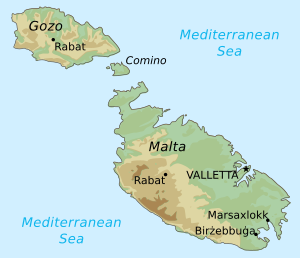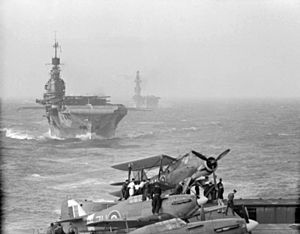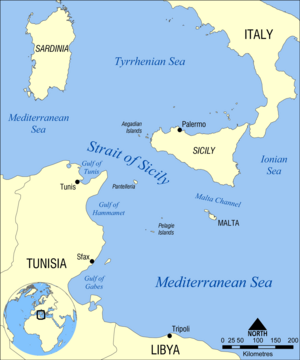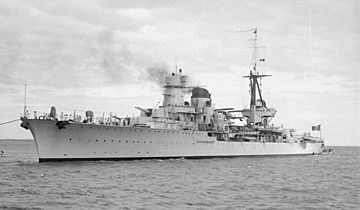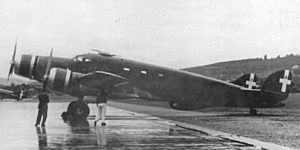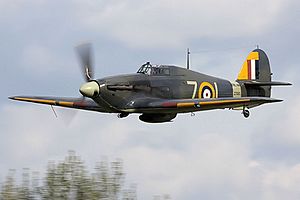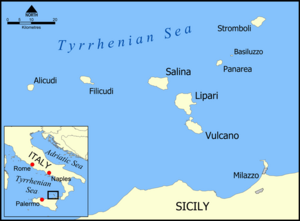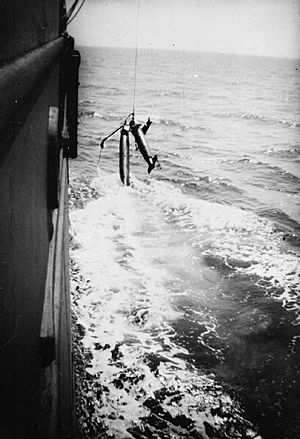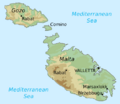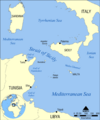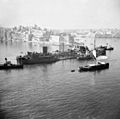Operation Pedestal facts for kids
Quick facts for kids Operation Pedestal |
|||||||
|---|---|---|---|---|---|---|---|
| Part of The Battle of the Mediterranean of the Second World War | |||||||
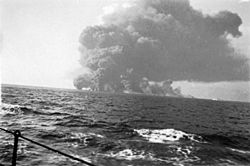 The column of smoke from Waimarama just after she exploded |
|||||||
|
|||||||
| Belligerents | |||||||
| Commanders and leaders | |||||||
|
|||||||
| Strength | |||||||
|
|
||||||
| Casualties and losses | |||||||
|
|
||||||
|
|||||||
Operation Pedestal (also called the Battle of mid-August by Italians, and the Santa Maria Convoy in Malta) was a very important British mission during Second World War in August 1942. Its main goal was to deliver much-needed supplies to the island of Malta.
Malta was a key base for British ships, submarines, and planes. From there, they could attack enemy convoys heading to Italian Libya. These convoys were vital for the Axis powers (Germany and Italy) fighting in North Africa. From 1940 to 1942, the Axis tried to cut off Malta with a siege, using air and naval attacks.
Even though the British lost many ships, they managed to get enough supplies through. This allowed Malta to keep fighting, though it couldn't launch many attacks in 1942. The most important supply in Operation Pedestal was fuel, carried by a special American tanker called Ohio. This ship had a British crew. The convoy left Britain on August 3, 1942, and entered the Mediterranean Sea on the night of August 9/10.
The Axis forces tried hard to stop the convoy using bombers, German E-boats, Italian MAS boats, minefields, and submarines. This was one of the last big Axis successes in the Mediterranean. Over 500 British sailors and airmen died. Only five of the fourteen merchant ships reached Grand Harbour in Malta.
Despite the high cost, Operation Pedestal was a big win for the Allies. The arrival of the Ohio and its aviation fuel was crucial. It helped Malta's air force attack Axis ships again. British submarines could also return to Malta. Supermarine Spitfire planes flown from the aircraft carrier HMS Furious helped launch more attacks. Italian convoys then had to take longer routes, making them easier targets.
The siege of Malta finally ended when the Allies took back Egypt and Libya. This happened after the Second Battle of El Alamein and Operation Torch. These victories allowed land-based planes to protect merchant ships sailing to Malta.
Why Malta Was So Important
Allied Plans and Malta's Role
The Allies were fighting the Western Desert Campaign in North Africa against Italy and Germany. Germany sent its Afrika Korps and many planes to the Mediterranean in late 1940. Malta was a key island for the Allies.
From Malta, British planes and ships could attack Axis supply convoys. These convoys were bringing supplies to the Axis forces in North Africa. Between June and October 1941, British forces sank about 220,000 tons of Axis ships. Most of these attacks were by Malta-based aircraft.
Because Malta was so important, the Axis launched many air attacks on the island in 1941 and 1942. By July 1942, Malta was running low on aviation fuel. There was only enough for the fighter planes. This meant they couldn't send out bombers to attack enemy ships.
Malta's Difficult Situation in 1942
Malta was in a very tough spot. An earlier attempt to supply the island in June 1942, called Operation Harpoon, mostly failed. Only two merchant ships reached Malta.
By August, food was scarce. People on Malta received very small rations of sugar, fats, bread, and corned beef. Workers got only about 1,690 calories a day. Women and children received even less. This was much less than what people ate before the war.
To save food, a mass slaughter of livestock began on the island. The meat was given to the public through "Victory Kitchens." Medicines were also running out.
It was clear that Malta would have to surrender if fuel, food, and ammunition didn't arrive soon. The local air commander, Air Vice-Marshal Keith Park, warned that aviation fuel would run out in a few weeks.
The British leaders, including Prime Minister Winston Churchill, agreed that losing Malta would be a huge disaster. So, they planned a new convoy operation from Gibraltar. This convoy would have an unusually large number of escort ships. These ships were taken from other fleets, including those that had been protecting convoys to the Arctic.
Planning the Convoy: Operation Pedestal
Allied Preparations
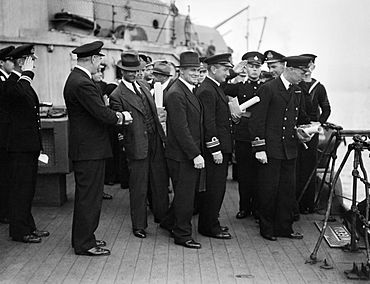
Planning for Operation Pedestal started in late July 1942. Vice-Admiral Edward Neville Syfret led the planning. The convoy included 14 merchant ships. The most important was the Ohio, a fast tanker loaned by the US to the British. It carried 12,000 tons of oil. Other ships also carried fuel in drums, just in case the Ohio was lost.
This convoy had the largest escort force ever seen:
- Two battleships
- Three aircraft carriers
- Seven cruisers
- Thirty-two destroyers
- Seven submarines
The entire group was called Force F. Different parts of the convoy and escorts had different names depending on their role and location.
Sending More Planes: Operation Bellows
At the same time as Operation Pedestal, another mission called Operation Bellows took place. The aircraft carrier Furious carried 38 Spitfire fighter planes to Malta. This was a "Club Run" to boost Malta's air defenses. Most of these planes successfully reached Malta.
Training and Diversions
The naval forces also did training exercises called Operation Berserk. They practiced anti-aircraft gunnery and emergency turns. This helped the convoy become very efficient at maneuvering.
Another operation, Ascendant, involved two merchant ships that had survived an earlier convoy. They sailed from Malta to Gibraltar at the same time Pedestal entered the Mediterranean. This was partly to confuse the Axis.
Axis Plans to Stop the Convoy
The Germans and Italians planned their attacks separately, though they tried to work together. The Italian Navy had many ships, but most couldn't be used due to a lack of fuel and air cover.
The Axis air forces had many planes:
- Italian Air Force (Regia Aeronautica): 328 aircraft (bombers, torpedo-bombers, dive-bombers, fighters).
- German Air Force (Luftwaffe): 456 aircraft (dive-bombers, medium bombers, fighters).
The Axis navies had 19 submarines in the western Mediterranean. They also planned to use torpedo boats and lay minefields. Their strategy was to attack the convoy in stages, hoping to scatter the ships. Then, their cruisers and destroyers would finish off the remaining ships. They especially wanted to destroy the British aircraft carriers.
Axis leaders knew a big Allied operation was coming. They thought the Allies might try to land troops on the North African coast or on Crete. This made them spread out their forces. German intelligence even believed a US aircraft carrier was part of the convoy.
The Battle Begins: August 9-11
Convoy Enters the Mediterranean
Force F, the main convoy, passed through the Strait of Gibraltar on the night of August 9/10. It was a moonless night with thick fog, so the British thought they hadn't been seen. However, German agents near Gibraltar did spot the convoy. The British knew this because they had cracked the German Enigma codes.
By the afternoon of August 10, the Axis knew a large convoy of 40 to 50 ships, including possibly two aircraft carriers, was heading east.
First Attacks and the Loss of HMS Eagle
On August 11, British ships refueled south of Majorca. At 1:15 PM, the German submarine U-73 fired torpedoes at the aircraft carrier Eagle. The Eagle sank just eight minutes later. About 231 men and almost all of its Sea Hurricane fighter planes were lost. This was a big blow to the convoy's air cover.
Later that day, German bombers attacked the convoy. They were met with strong anti-aircraft fire. Two German bombers were shot down. During the night, Allied planes attacked Axis airfields in Sardinia, destroying several aircraft.
Intense Fighting: August 12
Morning Attacks
On August 12, Axis planes continued to shadow the convoy. British fighters tried to intercept them but couldn't. At 9:15 AM, 19 German dive-bombers attacked. Four were shot down, and the British lost one fighter. Italian reconnaissance planes were also shot down.
The biggest air attack came around noon from Sardinia-based Italian planes. Waves of bombers and torpedo-bombers attacked the convoy. They were met by heavy anti-aircraft fire. Many aircrews dropped their bombs too early. One Italian plane, meant to be a radio-controlled bomb, crashed in Algeria.
Another attack by German bombers followed. One merchant ship, Deucalion, was hit and had to leave the convoy. In total, 117 Italian and 58 German planes attacked. They caused little damage for their effort.
Submarine and Air Attacks Continue
In the afternoon, Italian submarines tried to attack. One, Cobalto, was depth-charged and then rammed by the British destroyer HMS Ithuriel. The Cobalto sank, but the Ithuriel was badly damaged.
Later, more Italian and German planes attacked. The dive-bombers and torpedo-bombers worked together. German planes bombed the aircraft carrier Indomitable, hitting its flight deck twice. This seriously damaged the ship, killing 50 men and wounding 59. The Indomitable was out of action, leaving Victorious as the only working carrier.
Another attack by Italian torpedo-bombers hit the destroyer Foresight, which was later sunk by the British. The Axis air forces flew many missions that day. The British claimed to have shot down 39 Axis planes, but the true number was 18. The British also lost 13 planes in action and 16 when the Eagle sank.
Night Attacks and Chaos
As night fell on August 12, the convoy entered the Skerki Channel. Five Italian submarines were waiting. The submarine Axum hit the cruiser Nigeria, the cruiser HMS Cairo, and the tanker Ohio with torpedoes. The Ohio caught fire and had a large hole, but its crew put out the fire.
The loss of Nigeria and Cairo meant the convoy lost its leaders. Other ships were damaged or had to turn back. German bombers and torpedo-bombers attacked again. The merchant ship Brisbane Star was hit but kept going. Clan Ferguson was torpedoed and exploded. Empire Hope was sunk. The cruiser Kenya was also hit by a torpedo.
The convoy was in disarray. At midnight, German and Italian torpedo boats attacked. They hit the cruiser Manchester twice, flooding its engine rooms. The captain ordered the ship to be sunk, and the crew headed for the Tunisian coast. More merchant ships were sunk by torpedo boats.
The Final Push: August 13-15
Italian Cruisers Attacked
On the morning of August 13, British aircraft from Malta tricked Italian cruisers into turning away from the convoy. A British submarine, Unbroken, then attacked the Italian 3rd Cruiser Division. It fired torpedoes, hitting the cruisers Bolzano and Muzio Attendolo.
Muzio Attendolo had its bow blown off but managed to sail to Messina. Bolzano was hit in the middle, caught fire, and had to be beached. Both cruisers were out of action for the rest of the war. This was a big victory for the British submarine.
More Air Attacks and the Ohio's Struggle
The convoy was still about 120 miles from Malta. Axis planes attacked again. German bombers hit the Waimarama, which exploded in a huge fireball. The British destroyer HMS Ledbury rescued 27 survivors.
Another German plane crashed onto the Ohio. The Dorset was hit by dive-bombers and abandoned. The Port Chalmers was hit, but a torpedo got caught in its paravane (a device used to cut mines) and exploded harmlessly.
In the afternoon, the remaining merchant ships, Melbourne Star, Port Chalmers, and Rochester Castle, reached Grand Harbour in Malta. Unloading began immediately.
The Ohio was still struggling. It was towed by destroyers, but the tow lines kept breaking. Constant air attacks hit the tanker, damaging its rudder and breaking its keel. Finally, the Ohio was towed into Grand Harbour on August 15, to cheering crowds. The tanker discharged its vital fuel just before it settled on the bottom of the harbor.
Aftermath and Legacy
Losses on Both Sides
Operation Pedestal was very costly for both sides.
- Allies:
- Sunk: One aircraft carrier (Eagle), two light cruisers (Manchester, Cairo), one destroyer (Foresight), nine merchant ships.
- Damaged: One aircraft carrier (Indomitable), two light cruisers (Nigeria, Kenya), three merchant ships.
- Casualties: Between 350 and 550 men killed.
- Aircraft lost: 34 (including 16 Sea Hurricanes when Eagle sank).
- Axis:
- Sunk: Two submarines (Cobalto, Dagabur).
- Damaged: Two heavy cruisers (Bolzano, Muzio Attendolo), one light cruiser, one submarine, one E-boat.
- Casualties: About 100 men killed or missing.
- Aircraft lost: 48-60 (including those lost on the ground).
The Allies could not afford such heavy losses again. Another large convoy to Malta wasn't attempted until November 1942. By then, the Allies had recaptured airfields in Egypt and Libya, making it easier to provide air cover.
Malta's Survival and Future Convoys
After Operation Pedestal, Malta was resupplied. In September, Allied forces sank 100,000 tons of Axis shipping. This included 24,000 tons of fuel meant for German forces in North Africa. This shortage of supplies helped the Allies win the Second Battle of El Alamein.
Later convoys, like Operation Stoneage in November, arrived safely. This was thanks to land-based air cover. By December 1942 and January 1943, several more convoys reached Malta without any losses.
Honoring the Heroes
Malta had already been awarded the George Cross for its bravery during the siege. Many people involved in Operation Pedestal received awards for their courage.
- Vice-Admiral Syfret was honored for his "bravery and dauntless resolution" in leading the convoy.
- Dudley Mason, the captain of the tanker Ohio, received the George Cross. He was recognized for his "skill and courage of the highest order" in getting the valuable fuel to Malta.
- Other officers and crew members from both the Royal Navy and the Merchant Navy also received awards for their bravery.
Operation Pedestal was even featured in a 1953 British film called Malta Story. It used real footage of the Ohio alongside acted scenes.
Images for kids


